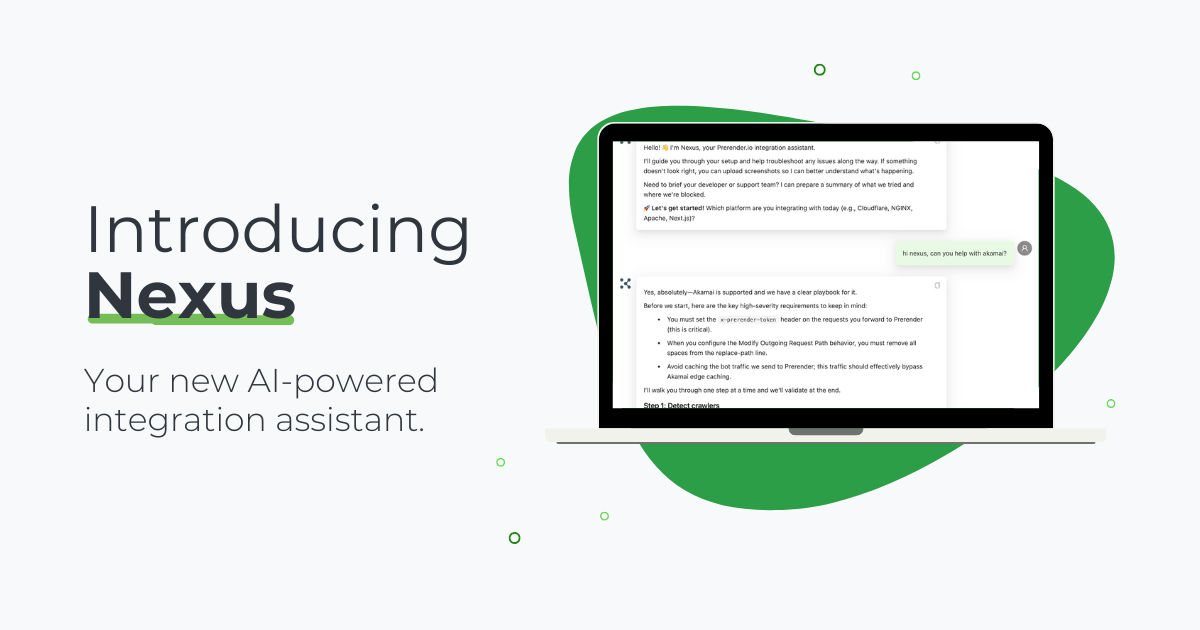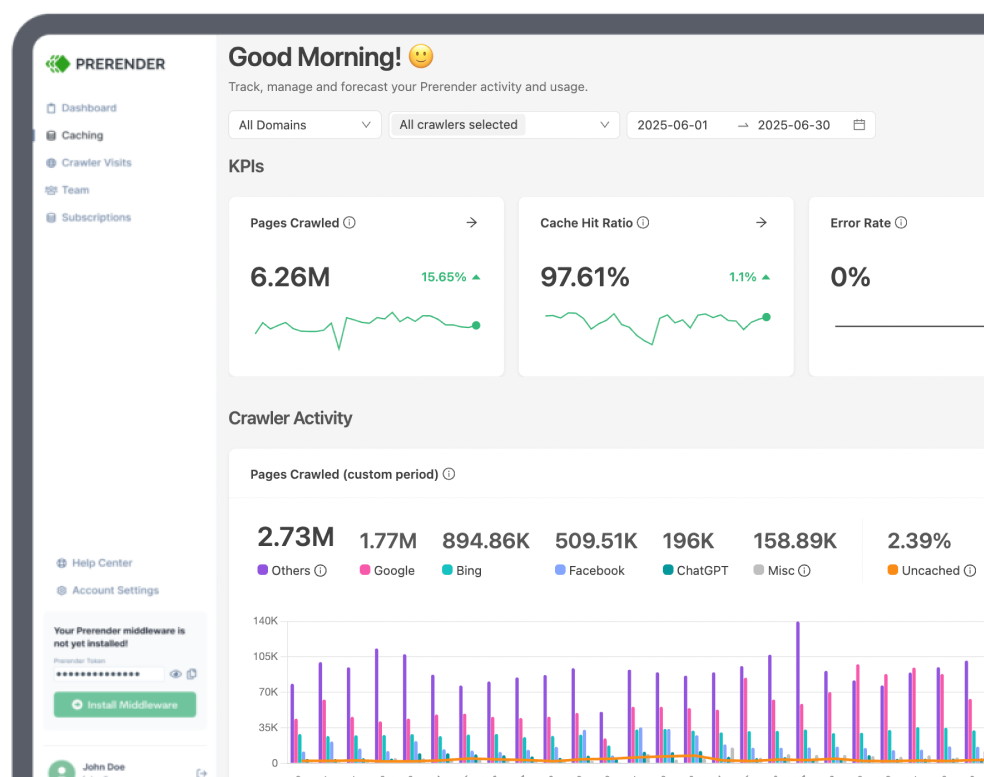Google Shopping and product snippets used to dominate ecommerce and marketplace search results. But that’s changing fast. With the latest updates from ChatGPT product search and Perplexity AI Shopping, consumers can now get product recommendations from LLM-powered search engines, too.
What’s important to note is that LLMs don’t index content like Google. Instead of ranking pages, they summarize, cross-reference, and selectively cite product listings they understand and trust. If your product feed isn’t optimized for AI—through proper product listing optimization and marketplace SEO—your products might be skipped, leaving them out of the AI shopping results.
In this ecommerce LLMO guide, we’ll unpack the new AI product search features, why your products aren’t mentioned in LLM searches, and how to optimize your product listings using specific AI SEO tools.
What’s New in Ecommerce and Marketplace SEO: Product Discovery via LLMs
ChatGPT Product Search Feature

Recently, ChatGPT rolled out its product recommendation solution as part of its search experience. For instance, when you search for “a toddler-proof water bottle under $20” on ChatGPT, you’ll get product suggestions pulled from Amazon, Etsy, and eBay, complete with their specs, reviews, and buy buttons. With OpenAI alone handling over a billion web searches every week, this is a game-changer for online shops, marketplaces, and anyone selling any product online.
Perplexity AI Shopping Feature
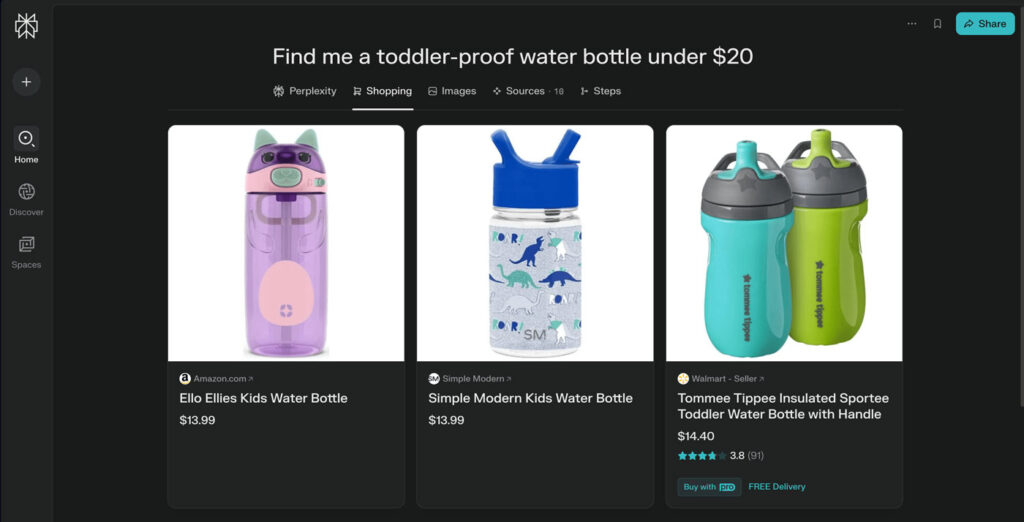
Besides the ChatGPT product search, Perplexity has also ventured into the ecommerce world through the Perplexity AI shopping feature.
In Perplexity, there’s now a tab dedicated to showcasing products directly from major shopping sites. For any ecommerce AI search query, this LLM-based platform spits out its product recommendation, complete with a one-click checkout (“Buy with Pro”) for eligible items.
Gemini with Google Shopping Feature
Google is also expected to blend LLM capabilities with its shopping ecosystem. Google’s Gemini is rumoured to soon integrate with Google Search and Shopping, pulling product listings from Google’s Merchant Center feed to answer users’ AI shopping queries.
What’s interesting is that they aren’t ads but organic listings pulled from structured, crawlable product data. With this new AI shopping approach, ecommerce product discovery is now happening inside the chat, not just in Google SERPs.
And just like when you optimized for SEO rankings in the past, it’s now time to optimize for citations, summaries, and inline product mentions in LLM responses. But first, you need to understand what is required to show up on LLM ecommerce listings and what some AI discoverability blockers are.
Why Your Marketplace Listings Don’t Appear in AI Search Responses
LLMs don’t use the same algorithmic signals as Google’s PageRank-based system. Instead, they rely on a mix of structured data, content relevance, and trust indicators to decide which products (or sources) to include in a conversational answer.
Think of an LLM as a curator selecting pieces for an exclusive exhibit. If your product listing lacks item labels (missing schema markup), is out of date (stale inventory), or lacks endorsements (poor or unverified reviews), it won’t make the cut. In other words, your products won’t be featured in the AI’s search results.
First time hearing schema markups? Learn more about different types of schema markups and how to implement them properly on your ecommerce website.
See the table below to learn more about why your ecommerce listings don’t get cited by AI search engines.
| AI Visibility Killer | What’s Going Wrong on the Product Pages | Why the LLM Skips Your Marketplace Product Listings |
|---|---|---|
| Missing schema markups | Your product title is keyword-optimized, but lacks tags like <product> or <offer> or schema markup. It’s missing key details like GTINs, sizes, or stock status. | LLMs rely on these clear, machine-readable signals to quickly understand your product. Without them, your listing can be invisible to AI. |
| Unoptimized product details | Your product description is short, copied from the manufacturer, and doesn’t explain how to use the product, answer common questions, or show customer feedback. | LLMs need detailed and helpful information to fully understand your product. Without it, they will skip your listing in favor of richer, more informative ones. |
| Poor customer reviews | You have few reviews or ones that look fake or unreliable, showing no clear signs of seller trustworthiness. | LLMs use buyer opinions and seller reputation to decide what’s trustworthy. Weak reviews or bad signals make the AI unlikely to recommend your product. |

Many marketplace listings don’t appear in AI answers because they haven’t been optimized or made accessible for the AI online shopping channel. Luckily, there are a couple of ways to fix that.
How to Optimize Marketplace Listings for LLM Visibility
1. Optimize the Product Metadata
If your product page is a suitcase of features, structured metadata is the passport that gets it through LLM customs. Without those machine-readable stamps, an LLM can’t tell whether your “Hydro-Hero Bottle” is a sippy cup, a sports flask, or a scented candle. So if you give the model everything it needs (up front, in JSON-LD), your listings will appear on LLM marketplaces.
Pro tip: Think beyond “ranking.” In the LLM ecommerce search landscape, your real goal is retrievability plus citability. Schema markups can help achieve both.
Here are some tips to optimize the metadata of your marketplace products:
- Product name that’s human-friendly and machine-readable
LLMs don’t guess but classify. If you have a product like a water bottle, you need to lead with the item’s archetype (e.g., “Water Bottle”), then layer in features or brand flair (“Toddler-Proof,” “Hydro-Hero”).
Strip away excess marketing buzzwords like “Ultimate” or “Revolutionary” unless they clarify the product’s purpose. Here’s an example:"name": "Hydro-Hero Toddler-Proof Water Bottle, 12 oz" - Crystal-clear product descriptions
Your product description is an elevator pitch for AI crawlers, so it needs to be use-case-driven and focused on functional value. When writing the product details, ask: Who is the product for? What does it do? Why does it matter? Your products will only show up in LLM searches if the description sounds like the answer to the query. - Global identifiers (SKU, GTIN, and MPN)
Global identifiers aren’t just inventory tools; they let AI systems reconcile listings across platforms. If your GTIN is indexed once, it can serve as a canonical link across every marketplace you appear on. That means stronger confidence signals and less duplication ambiguity. - Real-time product price and stock availability
LLMs hate dead links and outdated price and stock data. So, if your competitor’s listing is missing stock data while yours confirms availability, guess whose product gets cited? You.
Expose these values in a structured form to stay eligible for product recommendations in LLM-based search engines. Here’s a Product schema code to mark up product offers on a webpage."offers": {
"price": "18.99",
"priceCurrency": "USD",
"availability": "https://schema.org/InStock"
} - Verified customer reviews and aggregate product ratings
When embedded as structured data, verified social proof is a confidence booster for both the model and the end-user. LLMs treat these signals like testimonials. Omitting them is like submitting a résumé without references.
As Lokesh Joshi, an SEO expert helping brands grow online, explains:
“To optimize marketplace SEO listings for LLM visibility, start by researching how people naturally ask about your product and include those conversational queries in your keyword strategy. Use a clear, keyword-rich title, answer common customer questions implicitly, and add FAQ schema. Also, ensure your images have descriptive filenames and alt text, and include authentic reviews to boost trust and relevance in AI-driven recommendations.”
Related: discover the high-quality content that matches Google’s ranking standards.
2. Use Prerender.io to Ensure Your Products Get Seen by LLM Bots
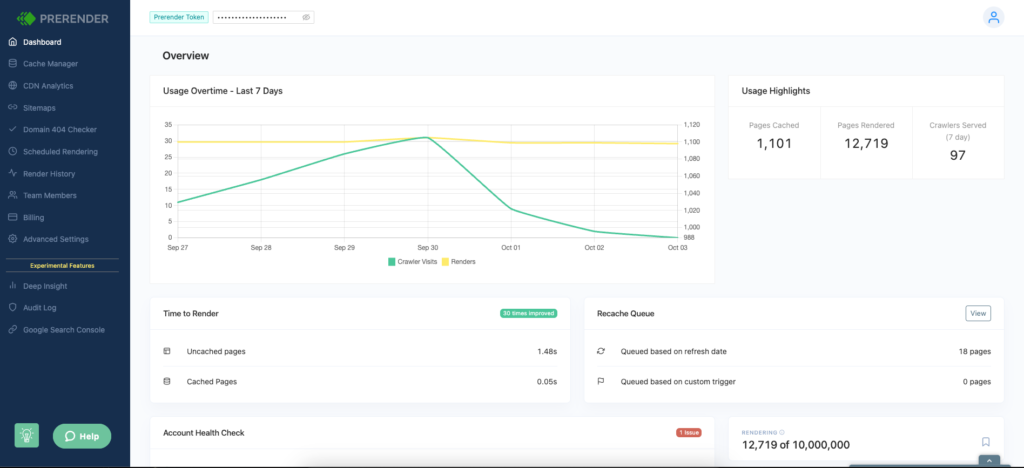
If AI crawlers can’t access your site’s content, your products won’t appear in their results. Many product pages load key details using JavaScript, including product photos and videos, descriptions, and prices.
Unfortunately, most AI crawlers can’t process JavaScript-generated content. When visiting your product listing, they face an empty page, causing them to skip it entirely. As a result, your products won’t be featured in LLM-powered marketplace searches.
To fix this, you need a JavaScript prerendering tool like Prerender.io. Prerender.io acts as a headless browser that renders your pages server-side and caches them for bots. It ensures every crawler—Googlebot, PerplexityBot, GPTBot (ChatGPT), and OAI-SearchBot included—sees the fully loaded HTML, complete with the crucial metadata and Open Graph tags.
In simpler terms, Prerender.io helps LLM bots read and understand your marketplace listings faster and more accurately, increasing your chances of getting mentioned on AI product searches.
By connecting Prerender.io to your ecommerce website, you no longer have to worry about marketplace SEO or getting a dozen AI SEO optimization tools. Even your infinite-scroll sections and lazy-loaded pages will be flattened into straight HTML, so search engines and AI crawlers will treat them like evergreen content blocks. The best part? You can get started with Prerender.io for free.
3. Update Robots.txt Files for AI crawlers
LLM search and shopping assistants start with the same question a classic search-engine spider asks: “Can I crawl this URL?” If your robots.txt answers “no” (or does not answer at all), your products may never appear in AI-generated answers, carousels, or citations.
Just as you wouldn’t block Google’s crawlers, don’t block AI bots. You can boost marketplace SEO by updating your robots.txt to explicitly allow relevant user-agents like OpenAI’s OAI-SearchBot and others (PerplexityBot, etc.). For example:
User-agent: OAI-SearchBot
Allow: /
This simple step can make the difference between being invisible and discoverable. If you have your own storefront or a blog that features your products, this is critical.
For marketplace product pages on platforms like Amazon or Etsy, you can’t edit the robots.txt. However, you can ensure any supplemental content you control (like your brand site) is open to crawlers.
See some robots.txt best practices for ecommerce websites here.
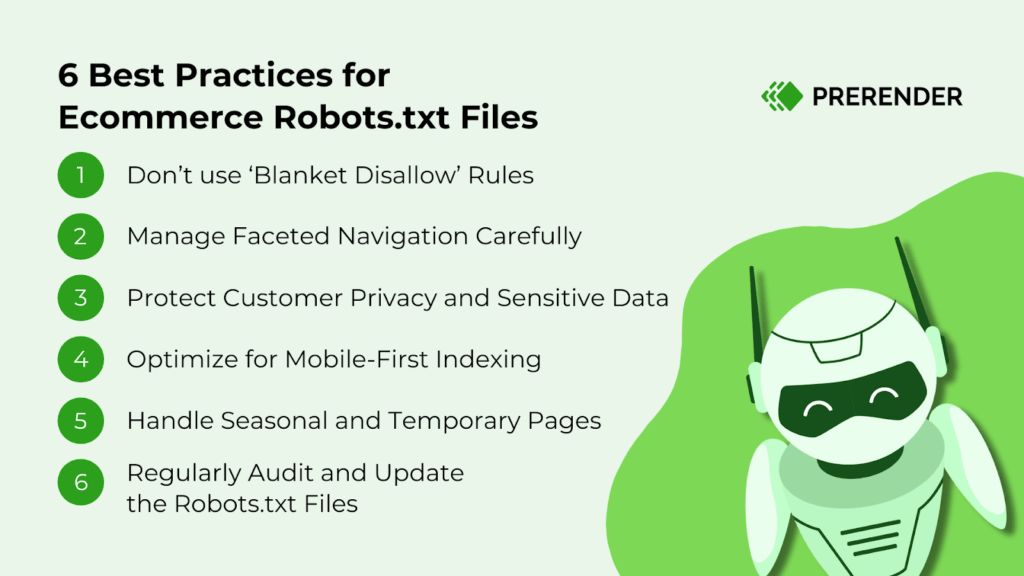
4. Submit Your Product Data Directly to AI Search Engines
If you want to boost your chances of showing up in AI-generated product recommendations, don’t just rely on the AI bots crawling, but push your data directly to the source. Some AI search engines now offer merchant programs that accept structured product feeds, giving you greater control over how your listings are surfaced.
- OpenAI is working on a product feed submission system for ChatGPT’s shopping results. It’s not live yet, but you can sign up for early access to have your products in as soon as it launches.
- Perplexity AI already has a live merchant program where retailers can submit product catalogs. This means your listings don’t rely on Perplexity bots to find; they come straight from the source with accurate pricing and inventory. If you’re interested, you can register your ecommerce website here.
By joining these programs, you’re not only making it easier for AI to find you, but you’re also keeping your product information fresh. If your price drops or something goes out of stock, the LLM-based search engines know instantly.
5. Enhance the Product Listing Descriptions With AI
One of the smartest ways for AI-friendly product listings optimization is to use AI tools in the creation process itself.
Many prominent marketplaces, retailers, and ecommerce websites use AI tools to write product titles and descriptions that are not only keyword-rich but also engaging to real shoppers. With the right AI prompt, you can get product copy that shows up in searches, makes sense to a language model, and feels like something a real person would say.
Here are some creative prompt ideas you can feed into ChatGPT (or any LLM search platforms) to generate higher-performing content for your marketplace listings:
- Title prompt
“I need a concise, descriptive title for a [product type] listing. The title should include the primary keywords [main keyword] and [secondary keyword], and highlight the product’s top feature [unique feature]. Keep it under 80 characters and make it attractive to click.”
Example use: If you’re selling noise-cancelling headphones, you might prompt: “I need a title for a noise-cancelling Bluetooth headphone listing. Include keywords ‘Wireless Headphones’ and ‘Noise Cancelling’, and highlight 30-hour battery life, under 80 characters.” - Feature bullet points prompt
“Rewrite the following product description in a [desired tone] tone: [insert your draft description]. Make it sound engaging to [type of customer] and include the key phrases [phrase1] and [phrase2] for SEO, without making them sound forced. Ensure the readability is easy (aim for short sentences and 6th-grade reading level).”
Example use: You can feed ChatGPT a dry manufacturer-provided description and ask it to rewrite it in a friendly, enthusiastic tone for everyday shoppers, while naturally blending in a couple of important keywords. - Tone and style adjustment prompt
“Rewrite the following product description in a [desired tone] tone: [insert your draft description]. Make it sound engaging to [type of customer] and include the key phrases [phrase1] and [phrase2] for SEO, without making them sound forced. Ensure the readability is easy (aim for short sentences and 6th-grade reading level).”
Example use: You can feed ChatGPT a dry manufacturer-provided description and ask it to rewrite it in a friendly, enthusiastic tone for everyday shoppers, while naturally blending in a couple of important keywords. - Comparison prompt (for product differentiation)
“Help me compare [Product] to its competition in one paragraph. Emphasize what makes [Product] unique (e.g., better materials, longer battery, affordable price) without naming the competitors explicitly. The goal is to position [Product] as the top choice for [use case or audience].”
Example use: If you’re selling a phone tripod: “Write a comparison-style blurb that positions our tripod as better—e.g., sturdier and more lightweight—than other phone tripods, to include in the listing description.”
Get Your Marketplace Product Listings Ready for LLM Search
Optimizing your marketplace listings for LLM visibility is essential for any ecommerce site aiming to lead in the emerging zero-click commerce market. If you want to capture your share of this new AI ecommerce landscape, relying solely on Amazon SEO won’t cut it anymore. You need to expand your strategy to include AI-driven search platforms.
Luckily, the ecommerce AI SEO playbook is simple:
- Open the door for AI crawlers to access your product listings.
- Make it easy for them to understand your product by surfacing real, credible customer reviews, updated pricing, and accurate product inventory. Use schema markups to help.
- Write product details that describe the products and answer the buyer’s AI search queries.
- Use Prerender.io to let AI crawlers process all your JavaScript-based product content.
Master these four steps, and your marketplace listings won’t just rank on Amazon or Etsy, they’ll be hand‑picked and cited by LLM-based search engines.
Ready to level up your ecommerce LLMO game? Sign up for Prerender.io today to get started!
Other GEO and AI SEO blogs that may interest you:

